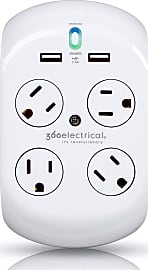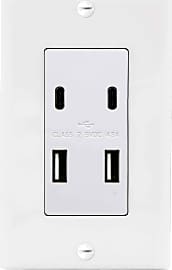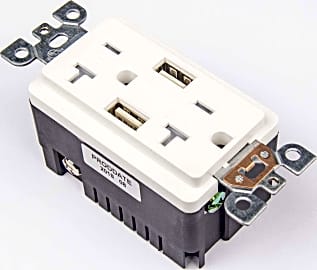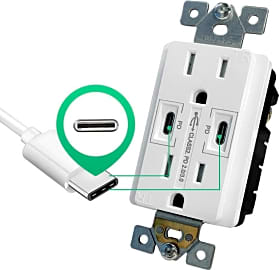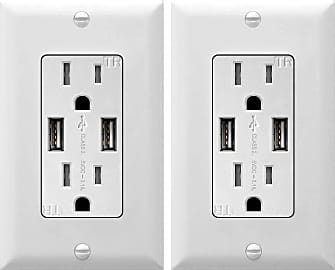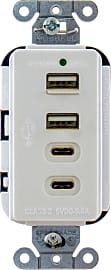The 10 Best Wall USB Outlets

This wiki has been updated 38 times since it was first published in August of 2015. Chances are you already rely on at least one USB-powered device in your daily life. As they continue to become increasingly ubiquitous, it'll make sense to install some wall outlets with built-in charging ports in your home, so you can dump the bulky adapters. All of our selections will ensure that your smartphone, tablet, and other gadgets stay powered up, with many capable of fast charging. When users buy our independently chosen editorial recommendations, we may earn commissions to help fund the Wiki.
Editor's Notes
December 23, 2020:
The latest smartphones and tablets now feature USB Type-C ports for rapid charging, therefore we took this into consideration when updating these USB outlets.
The Top Greener Ultra High Speed and the Szict 36W PD now have one and two USB Type-C ports, respectively, in addition to their Type-A ports and regular AC outlets. The Szict 36W PD boasts the highest output with both ports giving 18-watts each when used together, or an impressive 30-watts when only one is used, making it suitable for phones like the iPhone 12.
The Bryant Electric USBB4ACW and the Maxxima Vertical are two USB-only options that have also benefited from upgrading to Type-C. Both feature four ports that allow simultaneous charging through USB Type-A and C, however, the Bryant Electric USBB4ACW gives out slightly more power, and has a switch-activated protective cover, which, when closed, has a zero load draw.
December 12, 2019:
During this round of updates, we eliminated the Bestek Charging Dock and the AmazonBasics Surge Protector, due to availability issues. We also remove the Belkin SurgePlus – after noting several reports of fire hazards and poor performance, and replaced the Leviton Duplex with the Topgreener TU2153A – recognizing that the latter was an extremely comparable offering available at a much better price.
We also added several new options, including the Magnadyne WC-12V-B – a DC-option with a 12-volt outlet that’s great for use in campers and RVs, the Huntkey SMC007 – a modular model with a functional design we admired, and the Thor B2USB-20TR – a 20-amp duplex receptacle with two built-in USB ports that’s great for kitchen-renovation applications.
A few things to consider for this category:
Installation: While plenty of our selections are simple, plug-and-play options, easily installable by any homeowner with a shred of common sense, several of the items we ranked are hardwired pieces of hardware that should be connected by a reputable, licensed electrician – for safety’s sake, as well as that of your local bylaws. Some models that will likely require professional installation are the Topgreener TU2153A, the Bryant Electric USBB4, the Magnadyne WC-12V-B, the Thor B2USB-20TR and the Top Greener High-Speed.
Protection: While our rankings tend to require separate overcurrent protection, that will typically be provided through your electrical service. Notably, the Magnadyne WC-12V-B is also an unfused option, and will require a fuse wired in series with it, in order to properly protect connected equipment.
Some options listed here also offer additional protections. The Bestten Triple, the Belkin Cradle and the 360 Electrical all offer integral surge protection, while the Huntkey SMC007 includes overload protection with a built-in reset button – which is nice, compared to common options that need to be unplugged and then plugged back in to initiate a reset.
Utility: It goes without saying that options with more outlets should, theoretically, offer more versatility, but there are several models we ranked here that also stand apart from the crowd in a number of different ways. The Top Greener High-Speed features a USB-C port, for those who like to keep an eye on the future, while the 20-amp capacity of the Thor B2USB-20TR bests the 15-amp models in in the category. The Magnadyne WC-12V-B is the only option ranked here that’s designed to run on a 12-volt power supply, and portable options like Anker PowerPort 4 are a convenience if you like to keep one of these offerings stashed in your carry-on luggage.
Why You Should Upgrade To USB Wall Outlets
The world of technology is downsizing, and that extends to the size and shape of its wall outlets.
The modern electrical outlet has been around since the early 1900s, making this style of an outlet a staple of every home today. You've likely had several two and three-prong outlets in every room of your home since you were born. When something has been such an integral part of the landscape of your life, it can be hard to adjust to the idea of getting rid of it. But USB wall outlets are the future.
There is no denying it when considering facts like this: by 2018, over half of internet activities will be done via a smartphone or tablet (both of which are, of course, USB devices). Smartphone subscriptions have also been growing by the billions in recent years, and that number is only expected to grow by 15 percent each year until 2020.
Product manufacturers have already begun to recognize the value of a USB outlet, with many of them including charging ports inside of desk lamps, speaker systems, and radios. If these everyday devices are including USB charging ports, it's no stretch of the imagination to believe that soon enough, these devices themselves will be USB chargeable. Change can be hard to accept but it can come fast. One can probably recall that just ten years ago, nine out of every ten houses had a landline telephone; today that number has been cut nearly in half. The world of technology is downsizing, and that extends to the size and shape of its wall outlets.
What To Look For In A USB Wall Outlet
Don't fret that a USB wall outlet eliminates your access to AC ones; many models still include several standard three-prong plugs, in addition to USB ones. Since you have devices all over your room, look for a USB wall outlet that has plugs on the top, bottom and sides. That way, you can easily charge items that need to sit on an elevated surface, or low on the ground, all at the same time.
Look for a wall outlet with surge protection that is rated at least 400 joules.
Some outlets even have a docking station for a smartphone, freeing up the other plugs for various devices. Those looking to save money on electricity should make sure that their USB wall outlet doesn't have any ghost power draw. Otherwise known as a phantom load, or vampire energy, this is a phenomenon through which appliances you are not currently using still draw power, and can increase your energy bill.
If you live with kids, look for a model with child-safe port covers. Every day, seven children are rushed to the emergency room due to electrical shock from playing with a wall outlet. Look for a wall outlet with surge protection that is rated at least 400 joules. This will prevent dangerous electric surges in your devices. If you are worried about installation difficulties, many USB outlets plug in directly over your existing AC outlet with little or no screwing necessary.
When you believe your smartphone has been charging for hours, and are ready to leave the house, only to discover your device wasn't charging at all, it can ruin your day. So look for a USB wall adapter with indicator lights that confirm your devices are drawing power. Of course, if you are caught in that predicament, you'll be grateful if your outlet has rapid charging capabilities.
The History Of The Wall Outlet
We have Thomas Edison to thank for household electricity. After creating a lightbulb whose filament wouldn't burn out like previous models had, Edison needed a way to power his new bulbs. This forced him to build the first electrical station called the Pearl St. Plant in New York City. His plant created direct current electricity, but it soon discovered a pitfall; DC electricity could not travel very far without losing voltage. So Nikola Tesla stepped in and produced the alternating current (AC) system, which delivered electricity in cycles.
The third prong eliminated this problem and lay the groundwork for the model of AC outlets we see today.
The invention of AC electricity inspired many great minds to come up with ways for households to receive this power. A man named Harvey Hubbell came up with a separable attachment plug. His design connected directly to a light socket. However, the plug needed to be wired to the device that needed power. Hubbell eventually overcame this pitfall of his invention by creating a separable plug; one portion of it could be removed, while the other was left in the socket.
In 1928, Philip F. Labre brought us the three-prong plug. Before that, there had been a high incidence of electrical shock due to a short circuit. This would occur because when a person is holding an electrical plug and there is a short circuit, their body becomes the only path for the electrical current to the ground. The third prong eliminated this problem and lay the groundwork for the model of AC outlets we see today. In 2014, Panasonic released their USB wall outlet, and that changed everything.


